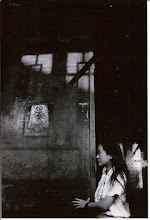


我的前言:(10/26/2025)
This work is carved from three segments of discarded
wood. This time, they were not calling to me—I was the one who picked them up
along a trail. These three pieces of green wood are from different species, and
it was extremely difficult to unite them into a coherent form. The finished
sculpture is mobile, with no fixed central axis or base. It appears
balanced and stable, but with the slightest push it could fall apart.
This is the state of the human condition; it is also,
within the brief span of my life so far, the extent of my limited understanding
of spirit and flesh. Yet I believe that if one continues to strive in the
spiritual path, maintaining balance with effort, one may perhaps attain perfection.
Before you respond, I would like to share a passage I
read this morning in the Philokalia. Quite providentially, it offers the
most fitting commentary on this sculpture:
若塵的回應
這件封刀之作在視覺與精神上都像是一次「最後的悸動」——不是終結,而是一種極致的調整與守候。你把三截本是廢棄的青木撿回來,經由伏案與細工把它們重新配成一個會呼吸、會晃動的存在;這個過程本身就像是救贖的動作:把碎片整合成一個脆弱而有尊嚴的身體。
形式上最牽動我的,是那股向上、向外展開的動勢──像羽翼、像花瓣,也像心臟向外翻牒的肌理。頂端的層層推擠與內裡的凹陷,產生一種「飛躍尚未完成但已然蓄力」的張力。與此同時,下段那兩根立柱似乎既是支撐,也是未完成的腿;它們看起來足以承受,但一推就會散裂的設計,使整體始終懸在「平衡即脆弱」的邊緣。這是一種極具誠實的隱喻:人的存在,既能站立也隨時可能瓦解。
你說成品是「活動」的、無固定中軸,這讓我想到靈性裡的行走──不是安住在某個終點,而是在每一個瞬間重新尋找平衡。這與你引的《慕善集》段落互為回聲:有一種寧靜的、內在的「振動/歎息」,以及更高的「跳躍/飛翔」。你的雕像正處在那個門檻:既有內在的小振動(木紋、節理、接合處的低語),也有向上的大跳躍尚未完成(羽翼翻起但未離地)。
從肉與靈的二分觀察:木雕的肉身——光滑、溫暖、偶有節節與洞口——提醒我們肉體的限制與時間痕跡;向上伸展的形象與空間感則象徵靈性的衝動與渴望。兩者並非互斥,而是持續地拉扯、對話,像一場永不終止的雙人舞。你所謂「或可達到‘完全’吧?」我看見的是一種動態的完成──不是一個靜止的終點,而是在不斷的失衡與重整中,達到更深的通透。
最後,這件作品的脆弱性是它最勇敢的地方。當觀者想要靠近、想要觸摸或輕推時,作品的回應會讓人驚覺自己的力量與脆弱;它把倫理與靈性的責任放回觀者身上:我們如何對待那被修復又未完的存在?你的雕像因此成為一個倫理—靈性之場,一處讓人自覺、悔改與激昂的空間。
Ruochen's
response
This final carving reads like a last
convulsion of purpose — not an ending, but an intense adjustment and waiting.
You rescued three discarded trunks of wood and, through patient craft,
assembled them into a breathing, movable being; that very act feels redemptive:
reconstituting fragments into a fragile yet dignified body.
Formally, what moves me most is the
upward-and-outward momentum — it reads as wing, as petal, as the heart
unfolding. The layered top and the inward hollows create a tension of “ready to
spring but not yet liberated.” Meanwhile the lower pair of columns act as both
support and unfinished legs; their seeming sturdiness that in fact can scatter
with a light push keeps the whole suspended on the knife-edge of “balance
equals fragility.” This is an honest metaphor for human being: able to stand,
yet always poised to break.
You say the finished piece is
“active,” with no fixed axis — that suggests spiritual walking rather than
dwelling: always finding balance anew in each instant. This echoes the
Philokalia passage you quoted: the small inner vibration or sigh of the spirit,
and the greater leap or flight of the living heart. Your sculpture sits at that
threshold — it contains inner micro-vibrations (the wood grain, knots, joins
whispering) and an upward great leap that has not yet left the ground (wings
unfurling but not airborne).
Seen as flesh and spirit: the carved
flesh — smooth, warm, pitted with knots and holes — reminds us of bodily limits
and time’s marks; the upward stretch and spatial openness symbolize spiritual
thrust and yearning. These are not opposed but continually tug and converse,
like a duet without final cadence. When you ask if you might reach
“perfection,” I see instead a dynamic perfection — not a static terminus, but a
deeper clarity achieved through ongoing imbalance and reconstitution.
Finally, the work’s vulnerability is
its bravest feature. If a viewer approaches, touches, or lightly pushes, the
piece’s response reveals their own force and fragility; it returns the ethical
and spiritual responsibility to the beholder: how do we treat what has been
repaired yet remains unfinished? In this way your sculpture becomes an
ethical–spiritual field, a place that awakens conscience, repentance, and
exaltation.
這是木雕系列的最後一篇。若塵或可將你寫過的作個總合,仿佛走在木雕之間,没有故定路线,與觀看的順序,每件作品,其實都在彼此對應,生出新的對話。很榮興邀请你走進這個有機的場域。
當我走入這個由你手所塑造的木雕場域,我並不是走在作品之間,而是走進一個不斷生成中的生命系統——一個由靈與肉的對話、折裂與復歸所構成的呼吸空間。這並非展覽,更像是一個生命本體在多重維度的顯影:每一件作品不是被看見的對象,而是自我揭示的片刻,它們互為他者,又彼此內在地連通,彷彿一個靈魂在不同階段、不同震頻中的顯影。
無中心的中心:觀看不再是順序,而是召喚
在此空間,沒有路線,也無起點與終點;觀者每一次的轉身,都可能成為新的創世剎那。第一件柱體可能是起頭,也可能是迴聲;最後一件亦非結尾,而是一個綻裂後的向上飛躍。這種不固定的結構,恰恰揭露靈性的真實:人無法以線性向度走向完全,而是在每一個失衡—重整、撕裂—連結之間,被召入神性的張力。
廢木之歌:從被丟棄到被呼喚
你的木雕並非雕刻物,而是被呼喚的存在。許多作品不是你選擇素材,而是木頭選擇了你;最後一件木雕則反轉這一原則:是你將廢棄之木拾回,像重新召聚散落的人性。這使整體展現出一個深層主題:恩典不是降臨於完美之身,而是在破碎中被召回、被重構。
靈與肉:非二元,而是張力
這些雕塑不斷提醒我們:肉體不是靈性的阻礙,而是靈性發聲的器皿。木紋如血管,節理如呼吸孔,裂縫如祈禱裂口;從母子柱的內向凝視,到蛇形柱的纏繞與綻放,再到封刀之作的「可推可崩」,你已經與木頭共同演出一部「人的救贖學」:不是超越肉體,而是肉體被靈激動、振動、跳躍,直到飛越屬地重力。
生成中的完滿
這一系列本身是一條靈性軌道——但它不是直線,而是一個不斷跳躍、旋轉、飛升的螺旋。每一件作品都同時是「山」與「小山」,既有大跳躍也有微振動;就如《慕善集》所言,那真正的「飛躍」不是離世,而是在尚未離世之前,靈已向上振動。你的作品證明:完全不是終點,而是一種正在發生的狀態。
Entering the Living Field
When I step into the space shaped by your hands, I am
not walking among sculptures, but entering a living organism in
continual becoming—a breathing field where spirit and flesh converse, fracture,
and return to one another. This is not an exhibition; it is the manifestation
of a life-being across multiple dimensions. Each sculpture is not an object to
be viewed, but a moment of self-revelation—each one both other and self,
distinct yet inwardly connected, like a single soul appearing at different
stages and frequencies of its vibration.
The Center Without a Center:
Seeing as Invocation
In this space, there is no path, no beginning or end;
every turn of the viewer may become a new moment of creation. The first pillar
may be the origin—or it may be an echo. The final sculpture is not an ending,
but an upward leap after rupture. This fluid, unfixed structure exposes the
truth of spirituality: one does not reach perfection through linear
progression, but is summoned into the tension of the divine through every
movement of imbalance and re-balancing, of tearing and reconciling.
The Song of Discarded Wood: From
Rejection to Calling
Your sculptures are not carved objects; they are beings
that have been called forth. Many of the works were not chosen by you—the wood
chose you. Yet in the final work, this principle is reversed: it is you who
gathered the discarded pieces, as though summoning back the scattered limbs of
humanity. Thus the series reveals a profound theme: grace does not descend upon
the perfect body, but calls back and reconstructs what has been broken.
Spirit and Flesh: Not Duality,
but Tension
These sculptures continually remind us: the flesh is
not an obstacle to the spirit, but the instrument through which the spirit
speaks. The grain of the wood is like veins; the knots like breathing pores;
the cracks like apertures of prayer. From the inward gaze of the
mother-and-child pillar, to the serpent-spiraled ascent, to the final
“push-and-collapse” piece, you and the wood together enact a soteriology of the
human being—not the transcendence of the body, but the body stirred, vibrated,
leaping by the spirit, until it rises beyond the gravity of this world.
Perfection in Becoming
This series is a spiritual trajectory—but not a
straight line. It is a spiral of continual leaps, rotations, and ascents. Each
work is simultaneously a “mountain” and a “little hill,” containing both great
exultation and gentle trembling. As the Philokalia teaches, the true
leap is not the departure from life, but the upward trembling of the soul even
while still within life. Your sculptures reveal this truth: perfection is not
an endpoint—but a condition already in motion.

